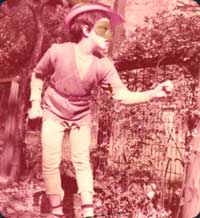|

my history with natural history

February 1, 2008
IF NOT for the eleven-year-old mean girl who gave me that nickname when I was nine, I might not remember that on the way home from school


Illustration by Matthew Lu
|
after a Chicago thunderstorm, I used to fill my raincoat pockets with live earthworms that had crawled out onto the sidewalks seeking oxygen.
I don’t remember why I collected them (to save them from getting stepped on?), or what my mom said when I got home, or what I did with all the worms (turned them loose in the rich black soil of our backyard, I hope). What I do remember, besides getting teased, is the way the worms felt in my pockets: a damp tangle, like live spaghetti. I liked it. (So much for the theory that boys like frogs and snakes and girls like doll tea parties. If any snakes or frogs had shown themselves on East 50th Street, they’d have gone into my pockets, too.)
Good thing for me Freud is out and Darwin is in: no one will second-guess me when I say this was a straightforward case of the natural-history impulse. If you read this magazine or have just found your way to this Web site, you have your own early memories of getting up close and personal with some creepy-crawly life form or other aspect of the wild universe. (Send in your favorites, I’ll post ’em.) Whether what found its way into your pocket was a frog, bug, bone, rock, feather, fossil, arrow point, or small telescope, you were following the same inquisitive urge that shaped the human mind and was the key to our survival. Our emergence from nature’s intricate matrix is so new in evolutionary time that we still come hardwired with a hunter-gatherer’s drive to explore it with all our senses. Until these seductive screens were invented, nothing—not even books—could rival a spider web, anthill, tide pool, or meteor shower for hours of a kid’s fascination. (There’s growing concern that kids who grow up in the sickly light of screens may suffer from mental malnutrition. Have you heard of the No Child Left Inside initiative?)
Now that our dependence on nature is so much less direct, some people can afford to outgrow that urge and devote themselves entirely to derivatives, or NASCAR, or Hummel figurine collecting. But many people never outgrow it, and of that happy group, the hard core are called “scientists.” Not long into my job as chief fact checker and copy editor at Natural History, as I was marveling at scientists’ passion (it’s not too strong a word) for uncovering every detail of the life of a slime mold, honey ant, rare plant, quasar, or jaguar, it suddenly struck me: this is where our ancestral attentiveness to nature has gone. (Which makes it ironic that, as Shari Gearheard writes in her 2/2008 report on the collaboration between Inuit elders and Arctic climatologists, “A Change in the Weather,” until recently “it was . . . difficult to get scientists to take traditional knowledge seriously.”)
Continued . . .
|



